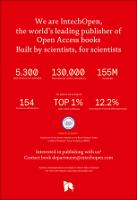Chapter Formability and Performance of Al-Zn-Mg-Cu Alloys with Different Initial Tempers in Creep Aging Process
Abstract
The initial temper may directly affect the deformation behavior and material performance in creep age forming (CAF) process. Five heat treatment states are selected as the initial tempers for CAF, namely, solution, peak-aging (T6), over-aging (T73), retrogression and re-solution. The formability and performance of an Al-Zn-Mg-Cu alloy with the above initial tempers in creep aging process are investigated via using creep and stress relaxation aging tests, mechanical property tests, corrosion resistance tests and microstructure analysis. The differences of formability are attributed to the inhibitions of different distributed matrix precipitates (MPts) on the dislocation movement, namely, the more coarsening the MPts is, the easier the dislocation movement. During creep aging process, the mechanical properties are improved for the solution, retrogression and re-solution tempers with fine MPts, but reduced for the T6 and T73 tempers due to coarsening of MPts. Since the distribution of grain boundary precipitates (GBPs) becomes discontinuous, the corrosion resistances of the creep aged specimens are enhanced for all initial tempers. Taking both mechanical properties and corrosion resistances into account, the re-solution temper may be a preferable choice to achieve high performance of the components beyond the precise shape in CAF.
Keywords
Al-Zn-Mg-Cu alloy, creep age forming, initial temper, precipitate, formability, mechanical property, corrosion resistanceDOI
10.5772/intechopen.70849Publisher
InTechOpenPublisher website
https://www.intechopen.com/Publication date and place
2017Classification
Metals technology / metallurgy


 Download
Download